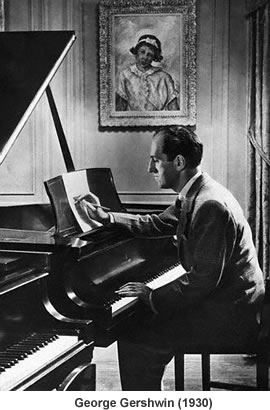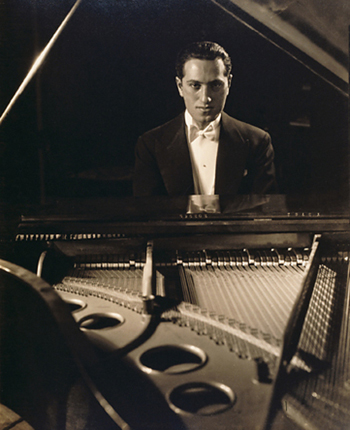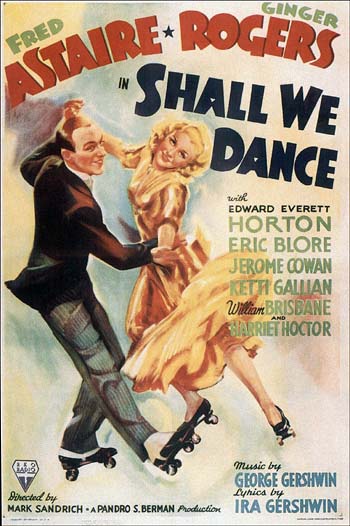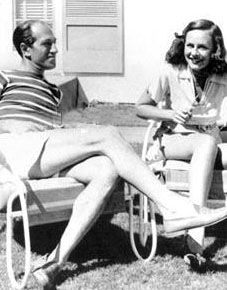The music of George Gershwin has 'Made in the USA' stamped all over it. Coming of age in the 1920s and 30s in New York City, Gershwin wrote music for a new generation of Americans.
On this broadcast, guest artist Dick Hyman—a brilliant pianist, composer and arranger for film, ballet and Broadway —joins The Jim Cullum Jazz Band to celebrate George Gershwin's works.
To this day, a pair of classic Gershwin Broadway show tunes remain the most-often-played standard vehicles for jazz musicians and their endless improvisations. The first, "Oh, Lady Be Good!," was the title tune of a 1924 stage musical starring the dance team sensation Fred and Adele Astaire.
The second Gershwin composition highly prized as a jazz vehicle is "I Got Rhythm" which debuted in the 1930 Broadway musical Girl Crazy. The chord changes of "I Got Rhythm" are so commonly used in jazz that musicians refer to them simply as "rhythm changes." This harmonic framework forms the basis of countless jazz standards, such as Count Basie's "Lester Leaps In," Duke Ellington's "Cotton Tail," Charlie Parker's "Anthropology" or Nat Cole's "Straighten Up and Fly Right." Dick Hyman says, "In jazz, there's a saying that either you're playing the blues or you're playing ‘I Got Rhythm.' Next to the blues, it's just about the most common jazz form."
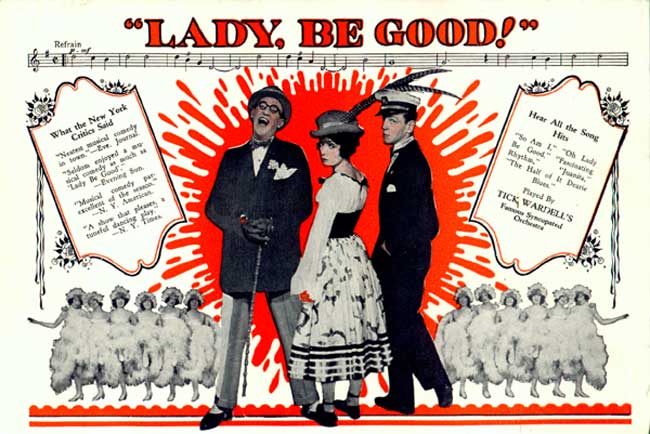
Fred and Adele Astaire are featured on a publicity flyer for the Gershwin hit, Lady Be Good, 1924. Image courtesy musicals101.com
George Gershwin's Song Book was published in 1932 and it includes the original sheet music and also Gershwin's own piano transcriptions—his songs the way he liked to play them. These transcriptions are all difficult arrangements. Gershwin explained, "Playing my songs as frequently as I do at private parties, I have naturally been led to compose numerous variations upon them and to indulge the desire for complication and variety that every composer feels when he manipulates the same material over and over again." At celebrity-studded parties in the living room of his Manhattan penthouse, Gershwin would often play versions of his "variations" arranged for two pianos with his friend Oscar Levant on second piano. Just such an arrangement from the Song Book is "Fascinating Rhythm" presented here in a performance recorded live with Dick Hyman and band member John Sheridan.
George Gershwin began composing his Piano Preludes in 1925. "Prelude No. 2" with its 12-bar blues structure lends itself particularly well to our jazz treatment by The Jim Cullum Jazz Band, enhanced by the two piano magic of Dick Hyman and John Sheridan.
Gershwin began his career in music at the age of 15 as a song plugger for Remick's, a music publishing house in New York. He'd spend his days in a small room—just about the size of a boarding house bedroom—at an upright piano, playing songs for singers and producers. At night his job was to make the rounds of popular saloons playing these same tunes for the publishing company with the idea that somebody important might hear a tune, like it and put it into a big show.
At the age of 21, George Gershwin got a huge break. The popular singing star Al Jolson heard his composition "Swanee" and fell in love with it. Jolson put it into his show Sinbad and (lucky for Gershwin) Jolson made a recording of it. Within days of its release, "Swanee" was being touted as "Al Jolson's Greatest Song" and Gershwin was riding high.
One of the first offers to come his way after the success of "Swanee" was a commission to write music for George White's Broadway Revue. These flashy annual shows featured big production numbers similar to the Zigfield Follies. The Scandals revues turned out to be George's ticket out of Tin Pan Alley into Broadway. Between 1920 and '24 George Gershwin wrote 34 songs for Scandals shows and two were long lasting hits—"Somebody Loves Me" and "I'll Build a Stairway to Paradise." From the title, we can imagine the elaborate stage production "Stairway to Paradise" might inspire. But when Gershwin played this piece for himself, he did it as a boogie-woogie. Dick Hyman gives a boogie woogie flavor to his interpretation of "I'll Build a Stairway to Paradise" in the performance heard here with The Jim Cullum Jazz Band.
On November 4, 1926, "The musical smart set," as Carl Van Vechten wrote in Vanity Fair, "gathered at the Hotel Roosevelt to hear George Gershwin play his five new Preludes for piano. It was the first public performance of these pieces Gershwin titled, "The Melting Pot." The Preludes were to be the introduction to a larger 24-part work offering musical snapshots of New York City life. The larger work was never written. On this broadcast, Dick Hyman joins The Jim Cullum Jazz Band to perform George Gershwin's three surviving "Piano Preludes."
Hollywood lured George and his brother Ira to California to write music for the movies. Working on the score for the Ginger Rogers and Fred Astaire movie Shall We Dance?, George fell under the spell of life in Beverly Hills. It was far more relaxed than life in New York. In L.A. he could hang out and play poker with his musical heroes Irving Berlin and Jerome Kern. He enjoyed the racetrack and had his own personal body trainer. In California George was so distracted by his golf game, he once said. "If I expect to write more music, I shall have to curb my love for golf...unless some farseeing golf club will place a Steinway at each tee."
In 1937 George and Ira were at work on Damsel in Distress, a new movie for Fred Astaire with leading lady Joan Fontaine; and the Gershwin brothers quickly wrote "Nice Work If You Can Get It" and "A Foggy Day" for the movie. About this time, George met the actress Paulette Goddard at a Hollywood party and fell madly in love with her. After gossip columnist Walter Winchell linked their names romantically, they saw each other only on the sly because—in true Hollywood style—she was secretly married to Charlie Chaplin.
Early in 1937 no one could have guessed how tragically the year would end. In June George started to get terrible headaches. He became moody and detached. The doctors couldn't find anything physically wrong with him and said his symptoms were caused by "overwork" or "'a nervous condition."
By early July George's headaches were unbearable. He stopped playing the piano altogether. His family continued to think his problems were strictly emotional and that he'd snap out of it.
On July 10th George fell into a coma and was rushed to the hospital. He had a massive brain tumor. Though he underwent emergency surgery, he never had a chance. He was 38 when he died on July 11,1937. The whole world mourned the passing of a truly American genius.
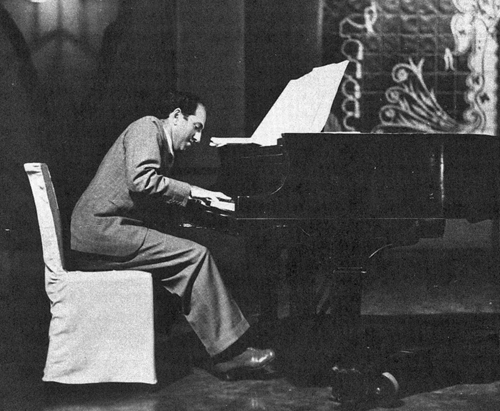
Last known photo of George Gershwin, taken at RKO conference, 1937. Photo from Gershwin in His Time ©1998 Gregory R. Suriano
Photo credit for hamoe page teaser image: 1925 cover of Time Magazine, Image from ‘Gershwin in His Time.’ Copyright 1998 Gregory R. Suriano
Text based on Riverwalk Jazz script by Margaret Moos Pick © 2011


